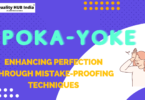Lean manufacturing’s main concept is actually fairly simple: work tirelessly to eliminate waste from the production process.
So, what exactly is waste? Any activity that does not add value to the customer’s experience is defined as waste. According to various studies, 70 percent of production operations in a normal industrial operation are waste, meaning they provide no value to the customer.
The good news is that by adopting lean manufacturing techniques and other manufacturing best practices, almost every organization has a huge opportunity to improve.
Techniques that allow you to deliver higher-quality products for a cheaper price. That’s something to get pumped up about!
Finding credible and well-written material about industrial improvement approaches can be tough. As a result, Quality HUB India not only presents you with the most up-to-date, easy-to-understand information through the blog posts, but by providing comprehensive courses on the subject through our Online learning platform to assist you in increasing the efficiency, effectiveness, and profitability of your manufacturing processes.
History of Lean Manufacturing
The history of Lean Manufacturing dates back many centuries, well before Ford’s renowned production lines for the Model T Ford, but it was with Toyota and the invention of the Toyota Production System that it became the ideology that we know today (TPS). Despite a lack of resources and infrastructure, Toyota set out to be considerably superior to Ford and the rest of the US automobile industry.
They were able to do it by employing Lean Principles and a variety of Lean Manufacturing Tools. Toyota admits that they are far from flawless and that they are only halfway through their never-ending Lean Manufacturing journey.
To comprehend what lean is, it’s helpful to know why it was created; once you know why it was created, you’ll be able to grasp exactly what it is. There are two key goals of Lean (and the Toyota Production System). Ensure that customers are satisfied and do so in a profitable manner.
Everything in Lean revolves around these two main themes, with customer happiness always taking precedence. Why are you doing that if the customer does not expressly want it? This is why, whenever you examine a process, the first question you should ask is WHY.
Too many lean practitioners apply concepts to a process without first evaluating why the process exists; as a result, they often make a wasteful process more efficient, and you wind up getting better at doing something the client doesn’t even want.
What are the 07 Deadly Waste (MUDA) of Lean Manufacturing?
Waste, or Muda in Japanese, is defined as a superfluous effort performed as a result of errors, improper planning, bad management, or poor communication.
Professionals in the field of quality control frequently discuss whether there are seven or eight lean wastes. The eighth lean waste differs from the other seven in that its eradication can directly benefit both employees and employers.
The Seven lean manufacturing mudas can be remembered using the acronym TIMWOOD.
- Transportation
- Inventory
- Motion
- Waiting
- Overproduction
- Over-processing
- Defects
The eighth waste often considered is “Unused Human Potential”.
05 Most Important Lean Techniques that will help improve Manufacturing Process
How can you choose the lean strategy that will have the greatest impact on your company when there are so many to choose from?
Reviewing the lean practices that are now proving themselves where it matters most – on the shop floor – is a solid strategy. Below is a brief overview of five excellent lean tactics, as well as a brief explanation of how each tool can help you enhance your manufacturing operations.
Keep in mind that, while many of these lean approaches can significantly impact your organization on its own, combining them can often multiply the benefits.
- 5S System (Systematic Way of Work Place Management)

The 5S method focuses on keeping your workspace organized. This method entails SORTING – removing what isn’t required. The remaining elements are then SET IN ORDER after that. Then you build a work environment that SHINE. After that, you STANDARDIZE the process by writing standards for each of the above aspects. Finally, you SUSTAIN the plan by adhering to the standards regularly.
These five necessary steps help to eliminate waste within manufacturing that can be produced from unorganized workspaces.
The 5S method eliminates waste that results from a disorganized work environment.
Kaizen is a proactive method in which employees work collaboratively to enhance the manufacturing process regularly.
This method works because it concentrates your company’s pooled talents and resources on building a culture that is constantly looking for ways to reduce waste in manufacturing processes.
- Six Big Losses (Focused Improvement through Loss Reduction)
Six universally occurring loss categories may usually be linked back to productivity inefficiency in practically any industrial area.
The following are the Six Big Losses:
- Breakdowns
- Adjustments and Setup
- Stops that aren’t big
- Speed Reduction
- Rejections from Set-Ups
- Rejection from the manufacturing process
The Six Big Losses method provides a framework for addressing the most common sources of waste in production.
- Overall Equipment Effectiveness (OEE)
OEE is a framework for calculating lost productivity in a manufacturing process. Downtime, Performance, and Defect rate are the three types of losses tracked.
OEE = Availability X Performance X Quality
This lean technique creates a baseline and allows you to track waste elimination progress in a manufacturing process. In the beginning, aiming for an OEE of 85 percent is a sensible goal to set. After that, you can concentrate on other techniques to improve your outcomes.
- SMART Goals
SMART goals are currently being implemented in a wide range of enterprises and departments, demonstrating the method’s utility. The acronym SMART stands for:
- Specific
- Measurable
- Achievable (Yet bit stretched)
- Relevant (To the business objective)
- Time-Bound
- Root Cause Analysis (RCA)
A root cause is a component that contributed to a non-conformance and should be eradicated permanently through process improvement. The root cause is the most fundamental problem—the most fundamental reason—that puts the entire cause-and-effect chain in motion that leads to the problem (s).
Root cause analysis (RCA) is a word that refers to a variety of approaches, tools, and procedures used to identify the root causes of problems. Some RCA approaches are more directed toward uncovering actual root causes than others, while others are more general problem-solving procedures, and yet others just provide support for the root cause analysis core activity.
CONCLUSION:
Various studies show that about 70% of production activities in manufacturing operations around the world are waste. When it comes to avoiding waste, producing high-quality products, and cutting total production costs, almost every organization has potential for improvement.
If you decide to go lean, keep in mind that putting the right procedures, tools, and mindsets in place takes time.
Your team(s) will be able to eliminate one or more of the Seven Types of Waste simply by doing their work once they’ve learned these approaches.
When it comes to going lean and implementing lean concepts, it’s critical to constantly keep the human factor in mind. This entails making it a priority to keep people happy and motivated at work. People will disconnect and not perform at a consistently high level if you don’t respect your employees and the people in your organization.
It’s a simple principle to apply because there are only a few things to remember, but because you’re dealing with people rather than computers, each piece becomes more difficult to handle.
- Maintain a high level of personal responsibility for both achievements and failures.
- Employees should not be overworked.
- Always speak with employees directly to get to the bottom of any problem.
- Give them a sense of stability and variety in their tasks.
- Outline what their labor achieves and tie their purpose with their own aims to show them their reason.
PS: Share your experience of implementing or working on this methodology in the comment section.
Quality HUB India Offered “Lean Management” Online Courses:
Hindi Version:
- Basics of Lean Management and TPS
- Lean Expert Silver (Level 2)
- Lean Expert Gold (Level 3)
- 5S Expert
- KAIZEN Expert
- Advanced Value Steam Mapping (A-VSM)
English Version:
- Basics of Lean Management and TPS (Under Development)
- Lean Expert Silver (Level 2) (Under Development)
- Lean Expert Gold (Level 3) (Under Development)
- 5S Expert (Under Development)
- KAIZEN Expert (Under Development)
- Advanced Value Steam Mapping (A-VSM) (Under Development)









Nice blog on lean concept.
I love your youtube channel and has been a subscriber for more than 2 years. Thanks for your service sir !!
Thanks for sparing your time. Do check our other blog post as well.
Best blog i have ever seen on lean system.
thank you so much. can you write a detailed blog on IoT.
Thanks for your appreciation. Do check our other blog post as well.
[…] WHAT IS 3K IN LEAN MANAGEMENT?WHAT IS LEAN MANUFACTURING? […]
I have been following your YouTube channel for learning important quality assurance related topics and I would say you provide top notch content with your expertise in the field.
Thank you so much for your contribution to the community.
Best blog i have ever seen on all quality related topic. I am your big fan and i also follow your you tube channel.
This is the great thing to start your blog
thank you so much.